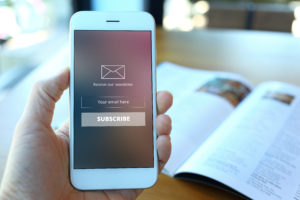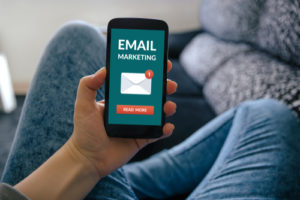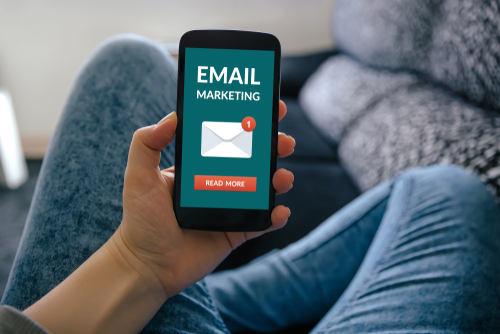First question… is email marketing dead?
The internet has certainly had a real impact on the way we communicate these days and also how we consume content. Email was once considered the fastest means of communication. There are so many ways to communicate today from video, artificial intelligence, virtual reality and chatbots; to a wide range of instant messaging platforms such as WhatsApp, Skype, Messenger and slack, its easy to think that email is dead.
Don’t be fooled, email marketing is very much alive and delivering great results when done well. Email marketing is still ranked as the most effective marketing tool, ahead of social media, SEO and affiliate marketing.
There’s a really good reason why that’s the case…
Email is fundamentally embedded in the technology that businesses use to operate their everyday activities. Yes, there are plenty of other great tools and new technology that are being heavily utilised, but most people in Great Britain are on email – 85% according to 2018 data. Its predicted that there will be over 3 billion users by 2020.
That’s why email marketing is so important, but you have to get it right to be successful.
Every day, we are all inundated with interruptions, adverts, invitations both welcome and unwelcome; our inboxes fill up fast. Sometimes it’s easier to hit the delete button. Remember this as we go through some easy steps to achieving success from your email marketing.
Growing your email list

email sign-up
To get started with your email marketing, you’ll need to build a list of recipients or grow the existing list you have.
Once you have an email list you can think about how to nurture and develop them. But as you may have already figured out, its pretty hard to capture email addresses from strangers. Getting readers to sign up for your email takes trust-building and effort and it takes time… no short-cuts.
Ideas for building your email list
Some businesses might give something away, others offer a newsletter, updates, promotions etc
Some ideas to help entice people to sign up include:
- Create a call to action (CTA) from each blog or landing page
- Create a pop-up or slide in on your website
- Use some humour
- Encourage subscribers to share or forward your emails
- Create a free e-book, checklist or whitepaper for download
- Create an informative series of emails which addresses challenges, issues, areas of interest for your target audience
- Create a survey and offer to share results with participants
- Promote via your social media channels
- Offer something fun, but useful ‘Make Mondays Matter’
- Use video content
Make sure you always have a strong call to action, so be sure to offer value. Explain what the emails are for, get people interested and let them see the value for signing up.
A note about GDPR
The General Data Protection Regulation (GDPR) is a legal regulation issued by the Council of the European Union and The European Parliament. Its main purpose is to protect the personal data of EU citizens. By actively encouraging sign-ups and sending business emails does mean you will be processing personal data so there are some key things you need to keep in mind when emailing in a GDPR environment.
Types of marketing emails
Now that you have a list of interested recipients, it’s time to step up your email game and follow through with some great content and deliver on the expectations you have set. Remember to be consistent.
There are a mix of different types of emails
Newsletter
A newsletter is an email you send regularly (monthly or weekly) to certain segments of your email list that helps you interact and build relationships with your leads and customers. Typically, these newsletters are summaries of recent content you’ve created.
Lead Nurturing
These emails are usually part of a connected series that guides users further down your sales or marketing funnel. They can be launched automatically whenever a user takes a specific action, such as downloading content, e-book, checklist or white paper on a landing page or requesting a trial. To maximize your returns with lead nurturing emails, it’s important to segment your audience by behaviours, interest areas, attributes, roles, pain points etc so you’re delivering highly targeted messages and content to your readers at every stage of the buyer’s journey.
Informational
Similar to a newsletter, this type of email delivers an update to a large group of readers. In these emails, you could send announcements relating to:
- New content, such as White Papers, blogs, industry briefs, technical paper, video
- Product updates
- Upcoming events
- Event updates
- Webinar – if you want readers to sign up for your webinar, your informational email should contain facts pertaining to registration
- Event information – times and dates of the event, a short description, and how readers can sign up
- Check-lists
Transactional
Once you’ve grown your email list a little bit, you need to think about how do you engage the prospects and customers you have a relationship with? Some will continue to be included in your Lead Nurturing emails. Transactional emails are automatically triggered when a reader performs a specific action, such as signing up for your newsletter, purchasing a product, completes a product demo and so on.
Here are the most commonly used transactional emails:
- Welcome emails – to a Newsletter, blog, monthly update
- Confirmation emails – confirm your order, order has been shipped, your booking is confirmed
- Follow-up emails – when people complete an online form on your website, send a follow-up email to say thank you for downloading, registering etc. also encourage social sharing or forwarding to colleagues and friends. They should be sent immediately following the action or activity

Writing a great email
As mentioned earlier, segmenting your list ensures that you’re delivering the right message to the right audience. Segmenting also delivers a more personalized experience for your reader and a higher likelihood that you will engage with the reader. Studies show that 57% of people say that getting too many emails from a sender or receiving irrelevant messages causes them to mark the content as spam.
Getting this right will increase your open rates, clickthrough rates, and conversions and getting your prospects through the marketing funnel and closer to that all-important sale.
Subject Line
A successful email marketing campaign starts with the subject line. You could have the best promotional message or the best product in the world but if nobody opens the email, they won’t know.
Keep the subject line short, ideally between 1 and 20 characters. This will yield higher open rates. More than 70% of people read their email on a mobile device, so keeping it short is great for mobile readability.
Engaging emails
Which email do you look forward to receiving the most? If you receive an email from a friend, one from a work colleague and one from a massive corporation? Which of these would you prefer to open and read? You’ll probably open the friend’s email first followed by the work colleague. Remember this when you create your emails, you’re trying to create an emotional connection, which already exists with your friends’ email, which is why you open it first.
To engage your audience and succeed you must be
- Relevant
- Trustworthy
- Memorable
- Conversational
Personalisation and the human touch is really important when it comes to creating your emails and getting the read by the recipient.
Understand how your emails are performing
To gauge how your email marketing efforts are performing, you’ll need to track a few metrics. If you can’t measure it, you can’t improve, so here are four measurements to get you started.
- Open rate
Your open rate shows how many people open your emails. It’s based on a single invisible tracking pixel that loads when someone clicks on your message.
If your open rate is low, it usually means you have a lot of unengaged subscribers. You need to work harder on providing value and engaging with this audience. - click-through rate, or CTR,
This shows how many people clicked on a link (if any) in your email. Its expressed as a percentage and represents the ratio of people who click on one or more of the links in your email, to the total number of people who opened your email.
CTR gives you immediate insight as to how engaging your content is for your readers. If the rate is low it means you need to work on either your message, your content or both. If your content is hosted on your website you will also see traffic to this page in your website analytics. - Conversion rate
A conversion is recorded anytime a reader takes action after following a link in your email. Similar to your CTR, it’s measured as a percentage. So if the goal of your email is to get readers to sign up for your next webinar, and 300 readers out of 10,000 do actually sign up, then your conversion rate would be 3%.
Email analytics are critical, they’ll give you very specific clues as to what you’re doing wrong and what you’re getting right.
Conclusion
Be successful, don’t ignore email marketing, it’s still one of the most powerful and highest performing marketing tools you can use. It doesn’t have to be too complicated, but you do need to get it right to see the results.
It’s always good to remember you’re a guest in the inboxes of your recipient and just one click away from losing them; with an unsubscribe.
Always follow through with the promises you make. Provide people what they’ve asked for and email on a regular basis, that will reflect positively on your brand. Segment your list as soon as possible so that you can automate messages and match the needs of your readers, depending on where they are in the marketing or sales funnel.
Keep monitoring the important metrics to see how well your emails are performing and resonating with your audience. Don’t be afraid to experiment and test different approaches. Don’t forget the importance of a strong subject line to help get the emails opened.
If you need an extra pair of hands to help you get it right, then get in touch hello@intelligentmarketing.uk.com






